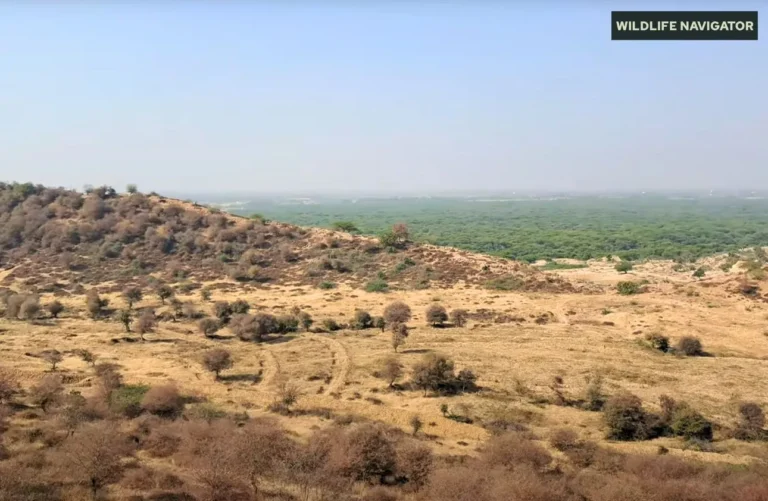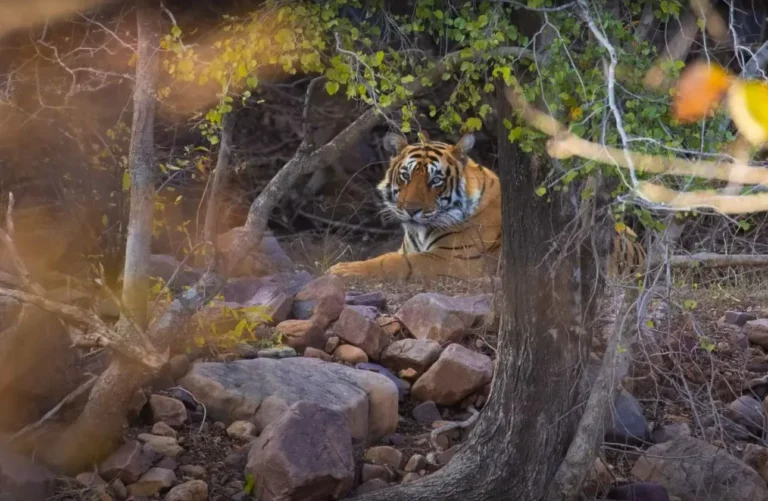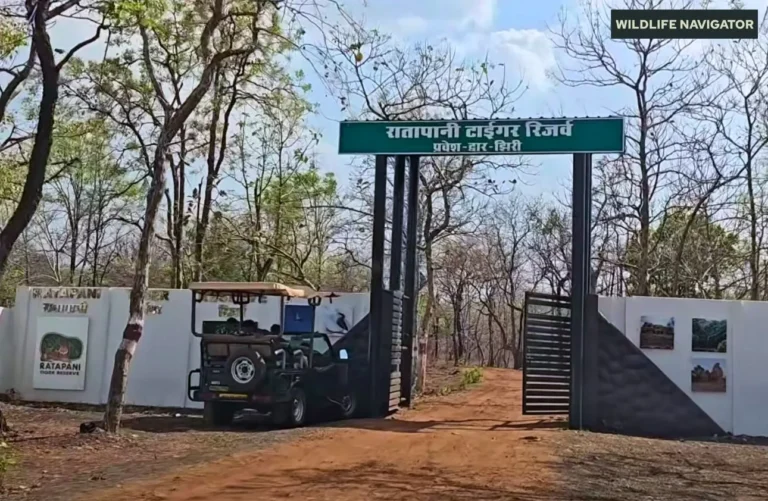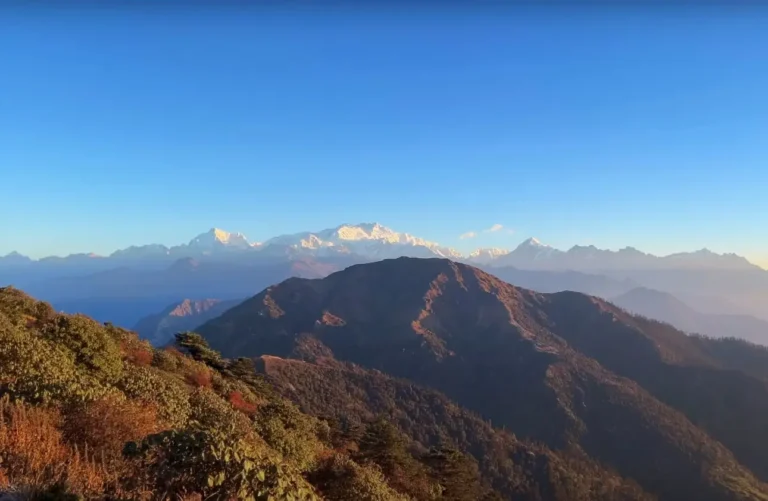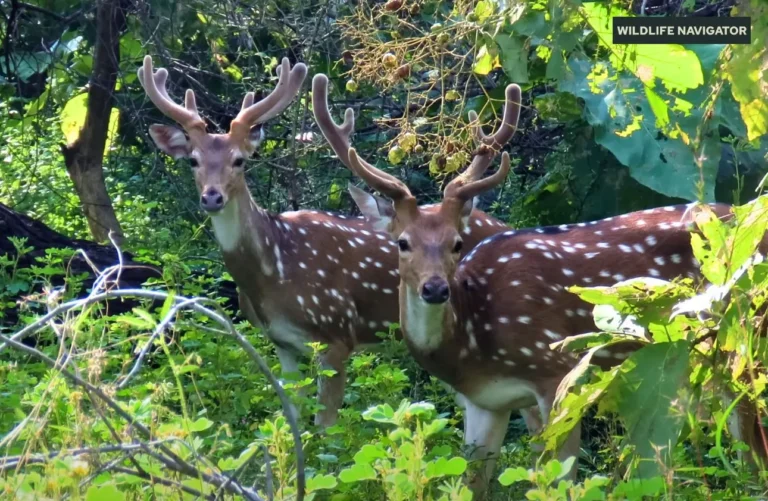Veerangana Durgavati Tiger Reserve, Madhya Pradesh
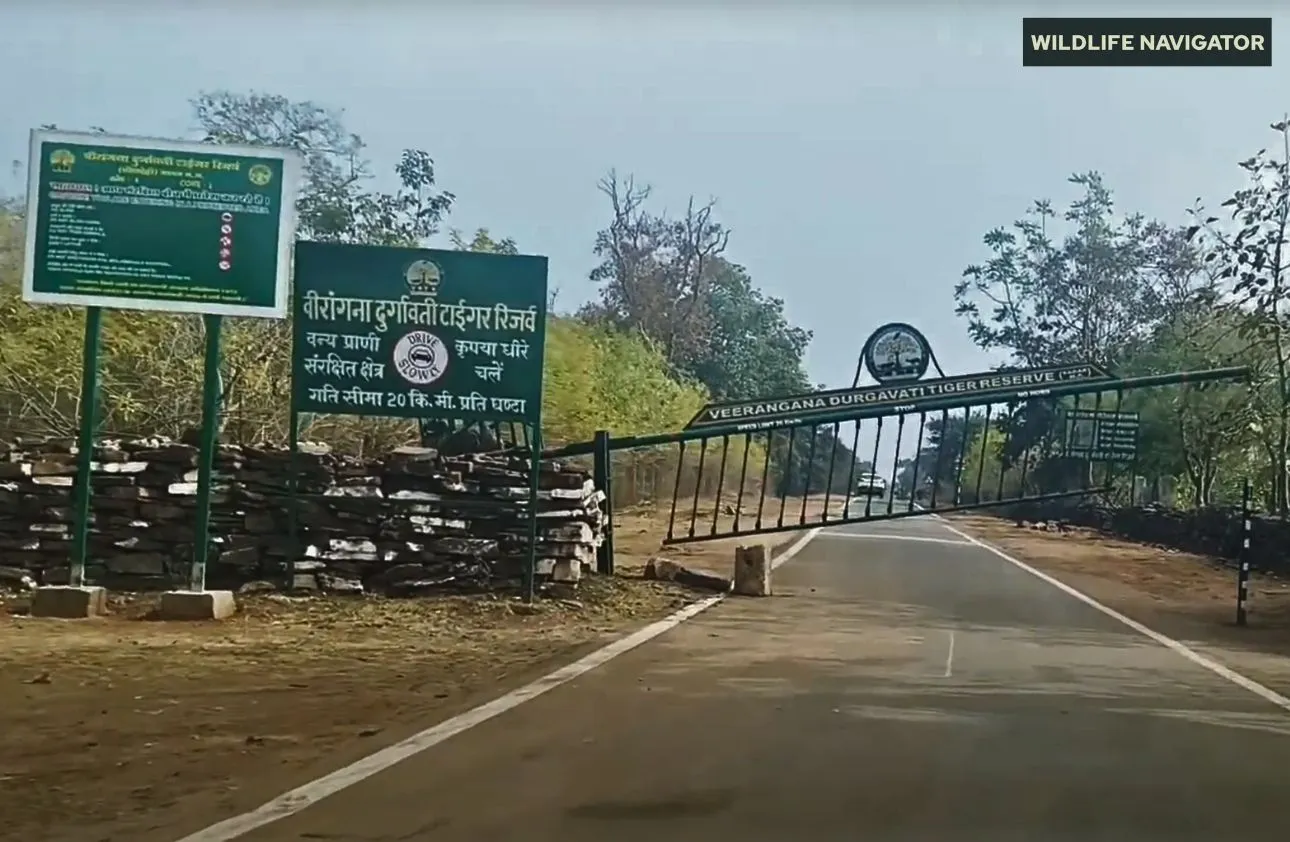
Veerangana Durgavati Tiger Reserve is one of India’s newest and most promising tiger habitats, nestled in the heart of Madhya Pradesh. Declared as a tiger reserve in 2023, it covers parts of Narsinghpur, Damoh, and Sagar districts, strengthening the state’s reputation as the “Tiger State of India.” The reserve is named after the legendary Queen Durgavati, the brave Gond ruler who fought valiantly against Mughal forces — a fitting tribute to the courage and spirit of India’s wild landscapes.
Situated strategically between Satpura and Nauradehi, it plays a vital role in connecting central India’s forested corridors, ensuring safe passage for tigers and other wildlife. This newly established reserve not only adds to the country’s tiger conservation network but also offers immense potential for eco-tourism, biodiversity research, and local community development. With its scenic landscapes and rich forest cover, Veerangana Durgavati Tiger Reserve is poised to become one of Madhya Pradesh’s must-visit wilderness destinations.
1. History, Geography & Landscape
1.1 Historical Background
The Veerangana Durgavati Tiger Reserve derives its name and inspiration from Rani Durgavati, the valiant Gond queen of the 16th century who ruled the region with unmatched courage and wisdom. Before gaining tiger reserve status, the area was known as the Veerangana Durgavati Wildlife Sanctuary, spread across the rich forest tracts of Damoh, Narsinghpur, and Sagar districts. In 2023, the National Tiger Conservation Authority (NTCA) officially notified it as a tiger reserve, recognising its ecological significance and its role as a natural corridor for tiger movement between Satpura and Nauradehi landscapes. This declaration elevated the region’s conservation importance, bringing it under stricter protection and scientific management.
1.2 Geography and Terrain
Covering an area of nearly 2,339 square kilometres, the reserve includes a core area of about 1,414 sq. km and a buffer area of around 925 sq. km. The terrain is a beautiful blend of undulating hills, river valleys, and plateaus. The Narmada River basin influences much of its geography, feeding smaller streams and wetlands that sustain the region’s wildlife. Dense teak and sal forests, interspersed with patches of bamboo and mixed deciduous vegetation, dominate the landscape.
The varied terrain not only supports a rich diversity of flora and fauna but also creates stunning natural scenery — from misty hilltops to sunlit meadows. Its location between established tiger strongholds like Satpura and Kanha National Park makes it a crucial link in India’s central tiger corridor, ensuring genetic exchange and long-term species survival.
2. Flora and Fauna
2.1 Flora of Veerangana Durgavati Tiger Reserve
The forests of Veerangana Durgavati Tiger Reserve showcase the vibrant beauty of Central India’s dry deciduous ecosystem. The vegetation here is dominated by teak (Tectona grandis), forming dense canopies that provide shade and shelter to countless species. Alongside teak, trees like saja, tendu, bija, mahua, dhawda, and bamboo create a multi-layered forest structure, offering both food and nesting sites for wildlife.
During the monsoon, the reserve transforms into a lush green expanse, with streams and seasonal ponds breathing life into the landscape. The mahua trees bloom in early summer, attracting both animals and local tribes who collect its flowers for traditional uses. The undergrowth, rich in grasses and shrubs, supports herbivores like deer and gaur — forming the foundation of the food chain that sustains the tiger population.
This mix of dense woodland, open meadows, and riverine vegetation ensures year-round biodiversity and ecological stability. The forest’s vegetation also plays a crucial role in maintaining the Narmada River basin’s hydrology, preventing soil erosion and aiding groundwater recharge.
2.2 Fauna of Veerangana Durgavati Tiger Reserve
The reserve is home to a fascinating variety of wildlife, representing the rich biodiversity of central India. The tiger reigns as the apex predator, with recent camera-trap studies confirming its movement through the area. Sharing this habitat are leopards, sloth bears, Indian wild dogs (dholes), and jackals, making it an active and balanced predator-prey ecosystem.
Among herbivores, species like sambar deer, chital (spotted deer), nilgai, wild boar, and Indian gaur roam freely across the forested landscape. Smaller mammals such as jungle cats, civets, porcupines, and mongoose are also commonly seen.
For bird lovers, the reserve is a paradise — with over 200 recorded species, including peafowl, crested serpent eagle, Indian roller, parakeets, and kingfishers. The presence of numerous reptiles and amphibians such as monitor lizards, pythons, and tree frogs, further enhances the ecological diversity.
Together, this thriving network of flora and fauna makes Veerangana Durgavati Tiger Reserve an essential link in Madhya Pradesh’s wildlife heritage — a sanctuary where nature continues its ancient rhythm, largely undisturbed.
3. Conservation Efforts & Challenges
3.1 Conservation Initiatives
Since its declaration as a tiger reserve in 2023, the Veerangana Durgavati Tiger Reserve (VDTR) has been under the active management of the Madhya Pradesh Forest Department and the National Tiger Conservation Authority (NTCA). These agencies have focused on protecting the reserve’s fragile ecosystem and improving habitat connectivity with nearby tiger reserves such as Satpura, Nauradehi, and Pench.
A key initiative is the creation of wildlife corridors to ensure safe tiger movement between forest patches. Regular camera trap monitoring, anti-poaching patrols, and GPS-based surveillance have been introduced to track animal movements and prevent illegal activities. Additionally, the forest department is working with local communities to promote eco-tourism and livelihood alternatives, ensuring that conservation benefits reach villages surrounding the reserve.
Awareness campaigns and joint forest management committees (JFMCs) have also been established to involve local people in protecting the forest, reducing dependency on forest resources, and preventing man-animal conflicts.
3.2 Challenges and Threats
While the future of VDTR looks promising, several challenges persist. Human–wildlife conflict remains a concern in buffer areas where tigers and leopards occasionally stray near farmlands or livestock zones. Habitat fragmentation due to road expansion, mining activities, and agricultural encroachment poses a serious threat to wildlife movement and genetic diversity.
Another issue is forest fire management, especially during the dry months when teak and bamboo forests become highly flammable. Unregulated grazing and resource collection can also disturb wildlife breeding grounds.
To address these issues, authorities are implementing scientific habitat management plans, promoting eco-friendly buffer zone development, and enhancing community participation through eco-development committees. With sustained efforts, Veerangana Durgavati Tiger Reserve is poised to become a stronghold of tiger conservation and an example of how new reserves can balance wildlife protection with human coexistence.
4. Eco-tourism and Safari Experience
4.1 Tourism Overview
As one of India’s newest tiger reserves, the Veerangana Durgavati Tiger Reserve (VDTR) is gradually opening up for eco-tourism and wildlife safaris. Though tourism infrastructure is still developing, the reserve’s serene landscapes, diverse habitats, and proximity to other tiger reserves make it a promising destination for wildlife enthusiasts and nature photographers. Visitors can explore dense teak forests, meandering rivers, rocky plateaus, and grassland patches that provide spectacular views of Central India’s wilderness.
The reserve’s core zones are being studied for regulated jeep safaris, ensuring that tourism remains sustainable and minimally invasive. Apart from jeep safaris, birdwatching, nature trails, and tribal cultural experiences are being promoted around buffer villages, encouraging responsible tourism that supports conservation and local livelihoods.
4.2 Safari Zones and Activities
Though official safari zones and entry gates are still being finalised by the Forest Department, potential access points include regions near Damoh, Narsinghpur, and Sagar districts, which are well connected by road. Visitors can expect future activities such as:
- Jeep safaris through buffer and core forest areas
- Guided nature walks to learn about flora and local ecology
- Birdwatching trails in riparian zones
- Eco-camping and night stays near designated eco-tourism hubs
These experiences are being designed under NTCA guidelines to ensure ecological sensitivity and minimal human impact on wildlife behaviour.
4.3 Best Time to Visit
The ideal time to visit Veerangana Durgavati Tiger Reserve is between October and March, when the weather is pleasant and the forests are lush with post-monsoon greenery. Wildlife sightings are more frequent during the cooler months, while summer (April–June) is excellent for spotting animals near waterholes. The park remains closed during the monsoon season (July–September) for habitat recovery.
4.4 Safari Charges (Approximate)
Although the final eco-tourism tariffs are yet to be officially announced, visitors can expect rates similar to other tiger reserves in Madhya Pradesh.
Here’s an estimated overview (per safari):
- Jeep Safari (Indian visitors): ₹1,200–₹2,000 per vehicle
- Jeep Safari (Foreign visitors): ₹3,000–₹4,000 per vehicle
- Guide Fee: ₹500–₹800 per safari
- Camera Fee (Professional): ₹250–₹500
All safaris are likely to require advance online booking through the official MP Tourism or Forest Department portal, ensuring regulated entry and fair visitor distribution.
5. How to Reach Veerangana Durgavati Tiger Reserve
Situated in the heart of Madhya Pradesh, the Veerangana Durgavati Tiger Reserve (VDTR) spans across three districts — Narsinghpur, Damoh, and Sagar. Thanks to its central location, the reserve is easily accessible by air, rail, and road, making it convenient for visitors coming from anywhere in India.
5.1 By Air
The nearest major airports are:
- Jabalpur Airport (approx. 120 km) – The closest and most convenient airport, offering regular flights from Delhi, Mumbai, Bhopal, and Indore.
- Bhopal Airport (approx. 220 km) – Another good option for visitors from western or southern India.
From the airport, travellers can hire taxis or use MP Tourism transport services to reach entry points around Damoh or Narsinghpur.
5.2 By Train
The region around the reserve is well-connected by railways:
- Narsinghpur Railway Station (approx. 30–40 km) – The nearest access point for visitors heading to the northern part of the reserve.
- Damoh Railway Station (approx. 40–50 km) – Convenient for travellers from Jabalpur or Sagar side.
- Sagar Junction (approx. 70 km) – Major railway hub for trains coming from Bhopal, Delhi, and Jhansi.
All these stations are linked to India’s main rail network, ensuring easy access for tourists from across the country.
5.3 By Road
Veerangana Durgavati Tiger Reserve is well-connected via national and state highways:
- From Jabalpur: 120 km via NH 44 (approx. 3 hours)
- From Bhopal: 220 km via NH 46 (approx. 5 hours)
- From Sagar: 70 km via SH 14 (approx. 2 hours)
- From Damoh: 45 km via NH 12A (approx. 1.5 hours)
Private taxis, state-run buses, and MP Tourism vehicles are available for convenient travel. The scenic drive through rural Madhya Pradesh offers a glimpse of local life and landscapes before you enter the dense forests of the reserve.
5.4 Travel Tip
Since the reserve is still in the process of developing visitor infrastructure, it’s best to confirm entry gate locations and permits through the Madhya Pradesh Forest Department or MP Tourism website before planning your trip. GPS navigation may not always work deep inside forest zones, so hiring a local guide or driver familiar with the area is recommended.
6. Accommodation Options
Although Veerangana Durgavati Tiger Reserve is still a relatively new addition to India’s network of protected forests, accommodation options are gradually developing around its buffer zones and nearby towns. Visitors can choose from forest rest houses, MP Tourism lodges, and eco-friendly resorts, ensuring a range of comfort levels while staying close to nature.
6.1 Forest Rest Houses & MP Tourism Lodges
The Madhya Pradesh Forest Department operates a few forest rest houses in and around the reserve, particularly near Damoh, Narsinghpur, and Sagar divisions. These provide basic yet comfortable stays amid the wilderness, ideal for nature enthusiasts and photographers.
The MPT (Madhya Pradesh Tourism) also offers well-maintained accommodations such as:
- MPT Jungle Resort, Damoh – Surrounded by greenery, suitable for families and small groups.
- MPT Kalchuri Residency, Jabalpur – A comfortable option for visitors arriving via Jabalpur Airport.
- Forest Guest House, Narsinghpur – Simple, budget-friendly, and close to buffer forest areas.
Bookings for these stays can be made through the official MP Tourism website or the Forest Department office.
6.2 Eco-Resorts and Private Stays
A few eco-resorts and homestays have started emerging near the reserve’s periphery, offering sustainable lodging options with local cultural experiences. These properties often provide:
- Locally sourced meals
- Guided forest walks and birdwatching
- Bonfire nights and tribal dance performances
Areas around Damoh and Narsinghpur are seeing new community-led eco-stay initiatives, where visitors can enjoy an authentic forest experience while supporting rural livelihoods.
6.3 Budget and Mid-Range Options
For travellers looking for affordable stays, towns like Sagar, Damoh, and Narsinghpur have several budget hotels and lodges with basic amenities. Many also assist in arranging safaris, local transport, and guides.
Approximate range:
- Budget hotels: ₹800–₹1,500 per night
- Mid-range lodges/resorts: ₹2,000–₹4,000 per night
- Forest rest houses: ₹1,000–₹2,000 per night (subject to availability and permits)
6.4 Booking Tips
- Book early during peak season (October–March), as options near the reserve are limited.
- Always check if your accommodation is inside or near the buffer zone, as entry restrictions may vary.
- For the best experience, choose eco-certified or MP Tourism-approved properties that follow sustainable tourism practices.
7. Nearby Attractions
Exploring Veerangana Durgavati Tiger Reserve isn’t just about wildlife — the surrounding region is rich in natural beauty, ancient heritage, and cultural landmarks that reflect Madhya Pradesh’s diverse charm. Visitors can easily extend their trip to include nearby national parks, fossil parks, and historical sites that showcase both nature and history in harmony.
7.1 Ghughwa Fossil Park (Approx. 50 km from VDTR)
One of the most fascinating nearby destinations, Ghughwa Fossil National Park near Mandla, is home to plant fossils dating back over 60 million years. The site offers a glimpse into prehistoric flora, making it a must-visit for nature and geology lovers. Interpretive trails and fossil exhibits help visitors understand the evolution of life in Central India’s ancient landscapes.
7.2 Satpura Tiger Reserve (Approx. 150 km)
A short drive away lies the spectacular Satpura Tiger Reserve, known for its rocky terrains, river safaris, and dense forests. Visitors can enjoy jeep safaris, canoe rides, and walking trails in one of India’s most pristine tiger habitats. Satpura is also one of the best-managed reserves in the country, ideal for wildlife photographers and conservation tourists.
7.3 Nauradehi Wildlife Sanctuary (Approx. 100 km)
Nauradehi forms an important ecological link with Veerangana Durgavati, acting as a tiger dispersal corridor. Spread across 1,200 sq. km, it is known for its open grasslands, wetlands, and sightings of tigers, wolves, and Indian foxes. The sanctuary is a great day-trip option for those keen to explore connected forest landscapes.
7.4 Cultural & Historical Sites
- Rani Durgavati Fort and Museum (Jabalpur): A tribute to the brave queen after whom the reserve is named, showcasing artefacts and historical relics from the Gond dynasty.
- Narmada River Ghats: Peaceful riverfronts along the Narmada offer scenic views and spiritual experiences.
- Sagar Lake and Temples: A pleasant stop for travellers heading back toward northern Madhya Pradesh, blending nature with local culture.
7.5 Suggested Wildlife Circuit
For travellers planning a wildlife circuit, combine your trip to Veerangana Durgavati Tiger Reserve with:
- Satpura Tiger Reserve → Nauradehi Wildlife Sanctuary → Panna Tiger Reserve
This route offers an unforgettable Central Indian wildlife experience, featuring forests, rivers, fossils, and vibrant tribal cultures along the way.
8. Travel Tips for Visitors
Visiting Veerangana Durgavati Tiger Reserve can be an unforgettable experience if you plan carefully. Since the reserve is still developing tourism infrastructure, following these tips will ensure both safety and a responsible wildlife experience.
8.1 Best Time to Visit
- October to March: Ideal months with pleasant weather, clear skies, and frequent wildlife sightings.
- April to June: Summers can be hot, but animals are easier to spot near waterholes.
- July to September: Monsoon season; reserve remains closed for habitat regeneration and safety reasons.
8.2 Packing Essentials
- Lightweight, breathable clothing for day, and warm layers for early mornings.
- Sturdy walking shoes for safaris and nature trails.
- Binoculars and camera with zoom lens for wildlife photography.
- Insect repellent, sunscreen, and hat to protect against sun and bugs.
- Water bottle and snacks, as facilities inside the reserve are limited.
8.3 Safari and Wildlife Etiquette
- Always follow the guide’s instructions during jeep safaris.
- Do not feed, provoke, or approach wildlife. Maintain a safe distance at all times.
- Keep noise levels low to avoid disturbing animals.
- Do not litter — carry all trash back or use designated disposal points.
- Avoid using drones unless explicitly allowed, as they disturb wildlife.
8.4 Permits and Regulations
- All visitors require entry permits, obtainable online via the MP Tourism or Forest Department portals.
- Carry ID proof when entering the reserve.
- Some zones may have restricted access, especially during breeding seasons; always confirm with local authorities.
8.5 Additional Tips
- Hire a local guide to learn about flora, fauna, and tribal culture.
- Plan early morning or late afternoon safaris for the best wildlife sightings.
- Respect tribal communities and local customs when visiting buffer areas.
- Keep emergency contacts and medical supplies handy, as forest zones may have limited connectivity.
By following these tips, visitors can enjoy an immersive and ethical wildlife experience, contributing to the long-term protection of Veerangana Durgavati Tiger Reserve.
9. Conclusion
Veerangana Durgavati Tiger Reserve stands as a shining example of India’s ongoing commitment to tiger conservation and ecological protection. Named after the courageous Queen Durgavati, the reserve not only preserves one of Madhya Pradesh’s most important wildlife corridors but also nurtures a thriving ecosystem where tigers, leopards, herbivores, and diverse flora coexist in balance.
As one of India’s newest tiger reserves, it offers a unique opportunity for eco-tourism, wildlife research, and community engagement, all while ensuring that its fragile forests remain protected for future generations. Visitors are encouraged to experience the reserve’s lush landscapes, scenic rivers, and vibrant wildlife with respect and responsibility.
By exploring Veerangana Durgavati, travellers contribute to conservation awareness, local community development, and the protection of Central India’s natural heritage. It is not just a destination but a call to witness, cherish, and protect India’s wild heart.
FAQ – Veerangana Durgavati Tiger Reserve
1. How can I visit Veerangana Durgavati Tiger Reserve?
Visitors can reach it by:
- Air: Jabalpur or Bhopal airports
- Rail: Narsinghpur, Damoh, or Sagar stations
- Road: Well-connected via NH 44, NH 46, and state highways from nearby cities.
2. In which state is Veerangana Durgavati Tiger Reserve located?
Veerangana Durgavati Tiger Reserve is located in Madhya Pradesh, in the central region of India.
3. What is the 7th Tiger Reserve in Madhya Pradesh?
In Madhya Pradesh, Veerangana Durgavati Tiger Reserve is the 7th tiger reserve officially notified under the National Tiger Conservation Authority (NTCA).
4. In which districts is Veerangana Durgavati Tiger Reserve located?
The reserve spans parts of Narsinghpur, Damoh, and Sagar districts in Madhya Pradesh.
5. Veerangana Durgavati Tiger Reserve in Hindi
In Hindi, it is written as: वीरांगना दुर्गावती टाइगर रिज़र्व.
6. Where is Veerangana Durgavati Tiger Reserve?
It is located in central India, in Madhya Pradesh, covering forested areas of Narsinghpur, Damoh, and Sagar.
7. Best time to visit Veerangana Durgavati Tiger Reserve?
The ideal visiting period is October to March, when the weather is pleasant and wildlife sightings are frequent.
8. Veerangana Durgavati Tiger Reserve is also known as:
It was earlier part of the Veerangana Durgavati Wildlife Sanctuary before being declared a tiger reserve in 2023.
